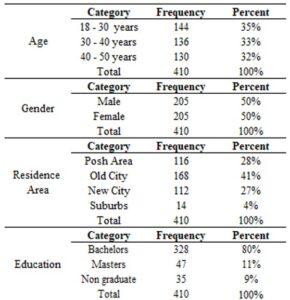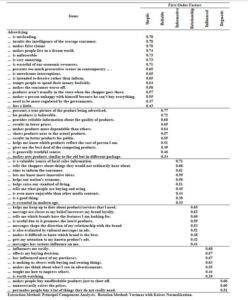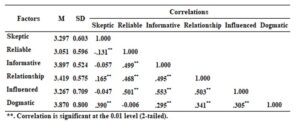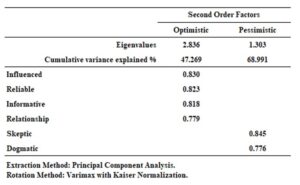Introduction
As advertising plays a crucial role in the consumer market, Saudi Arabia is also no exception. In a consumer society that is also ultra-conservative, women are not part of any advertisement, and if they appear, they are only showing their eyes. Interaction between male and female models (except family) cannot be shown. There is no concept of advertising models as in Western markets. Due to conservative thinking, most advertising is made outside the country and then translated into Arabic and used in local media and markets. This situation makes Saudi Arabia an attractive market for measuring public perceptions towards advertising and advertising models.
Following the Saudi Vision 2030, the Kingdom has witnessed many government changes related to economic policies. More reforms for business and attracting foreign investment so the revenue focus should be shifted from an oil-based economy. With those business reforms, the central area of change will be “Advertising.” Presently, local cultural and prevailing government policies have kept all advertisements under social and cultural boundaries.
Literature Review
Not much has been written about advertising in Saudi Arabia. One of the primary reasons for such ignorance is advertising as a foreign concept in Saudi Arabia. Hence, it is not surprising that it portrays aspects of the western culture that are foreign to the Saudis, such as technology, scientific inquiry, and an obsession with change and innovation. These elements have little to no significance in Saudi Arabia, where the emphasis is more on tradition, family, religion, and customs (Al-Yusuf, 1994). Another support comes from academia, where almost all public-sector universities offer undergraduate degrees in business, but not many offer majors in Marketing. Moreover, very few universities are offering a course on advertising on undergraduate or graduate levels.
Several countries worldwide are wary about the open flow of media and advertising since they consider it a threat to the sanctity of their cultures. Countries can be divided into three different categories, depending on the influence of religion and culture on advertising: (1) high religion dominance, e.g., Saudi Arabia and Iran, (2) high culture dominance, e.g., Japan and Korea, and (3) no culture or religion dominance, e.g., Austria and Sweden. They are mainly concerned with messages transmitted through Western media and their effects on the receiving society’s culture, values, and behavior (Al-Yusuf, 1994). These messages usually contain elements belonging to the Western cultures and the lifestyle of the people there, which is in stark contrast to those of other countries. In many developing countries, a variety of research has been carried out which suggests that television has the power and ability to eradicate the local culture of a country by injecting the whole or elements of new cultures which eventually disrupt “unidirectional media flow” (Al-Yusuf, 1994). Also, advertising allows people access to foreign ethical values, often shifting consumer demand to areas that obstruct development priorities and way of life (MacBride, 1980).
External factors that strongly influence the advertisement in Saudi Arabia are religion, socio-economic conditions, consumer orientation towards foreign products, environmental awareness, the infrastructure of local media, and regulatory control by the Government (Rau & Preble, 1987; Boddewyn 1980; Luqmani, Quraeshi & Deleno, 1980). Two factors are more dominant than others, religion, and culture (Wright, 1981). Therefore, the guidance for creating an advertisement in such a society is drawn from the culture and social norms (Luqmani, Quraeshi & Deleno, 1980). Advertisers know well that when they primarily stimulate their target market, they can significantly impact individuals (Weilbacher, 2003). Therefore, one of the major concerns for any advertiser is understanding its audience’s social and cultural standards. This understanding is then used to appeal to consumers to transform their purchasing and consumption habits. Effective advertisement increases sales and shapes consumer perceptions and choices (MacBride, 1980). It is also known that companies and personalities with great credibility create opinions and are referred to as “opinion leaders” (Protess & McCombs, 1991; Porter & Golan, 2006). At the same time, the masses are also aware that advertisements are just ‘fake acting’ by the male and female models shown in them (Iris Mayne, 2000). Generally, the central role of advertising is to promote and boost the sales of the producer. To encourage consumers to endorse and eventually buy the product, the adverts of these products promise the viewers the “ideal life” if they buy their product or service. However, in doing this, the adverts do not just provide the people with information about the offering; they also give rise to unreasonable expectations and demands (Al-Yusuf, 1994).
For years, television advertisements have been an integral marketing element, even more so in countries where television is the most popular medium. Commercials are known to communicate different cultural styles to their audience. For example, commercials tell us things from how we dress to organize our lifestyles and take steps to achieve our ideal self (Berman, 1981). The West is a place where this dynamic also exists: the influence of moral institutions has diminished due to the rising popularity of the media culture. In the last 50 years, people in the West have transitioned from church to college to television to pursue guidance regarding morals and everyday life (Berman, 1981).
Furthermore, some people feel that there is an imbalance of media flow between the West and the world. This concept is known as ‘media imperialism,’ and it shed light on international media flow. This concept is explained as a greater flow of media products flows from the USA to other places such as Asia. An insignificant amount is being exported in the opposite direction. The lack of exchange of media influence by the affected society combines the two elements of cultural domination and enforcement of power resources between the two countries (Barrett, 1979). One of the world’s largest multinationals, Procter and Gamble, also decided to address Saudi culture sensitivities when promoting its famous brand, Buitoni Pasta, in the Saudi market. Instead of using a female model in the product’s advertisement, the company decided to use a picture of the pasta and a slogan (Bankhar, 2015). Eliminating female models from advertisements is a method most companies use to advertise within Saudi Arabia, not to violate society’s values and norms.
Factors that strongly influence the advertisement industry in Saudi Arabia are religion, socio-economic conditions, consumer orientation towards foreign products, environmental awareness, the infrastructure of local media, and regulatory control by the government (Rau & Preble, 1987; Boddewyn 1980; Luqmani, Quraeshi & Deleno, 1980). Among these, the two factors that are the most dominant are religion and culture (Wright, 1981). The dominant religion in Saudi Arabia is Islam. Advertising via audio-visual techniques for promoting a product or service was unheard of in the time before Islam and now. The only method for promoting a product was through word of mouth and actual inspection of the item.
Nevertheless, specific guidelines were stipulated by the Quran and the Last Prophet regarding the proper way to sell a product. Therefore, Islam permits advertising if it does not go against specific guidelines and principles. For example, Muslims are encouraged to be honest in their presentation, not to deceive and make false claims, not to promote usury, not to promote deeds such as gambling and adultery, which Islam prohibits, to not deal in prohibited items such as drugs and dead meat, not to use obscene images and language, and to not attack the competition by discrediting them, (Al-Yusuf, 1994).
Research Methodology
The purpose of this research was to examine perceptions towards advertising in Saudi Arabia. The research questionnaire was developed using earlier studies and validated by the advertising/marketing experts in that field. The questionnaire consists of sixty questions generated from different studies (Pollay & Mittal, 1993; Mdlongwa, 2020; Bajaber, 2020). Earlier studies also partially used these questions (Siddiqui, Elahi, Bajwa, 2017; Siddiqui, 2011), or validated these questions (Fahim, Siddiqui, Anjam, Aziz, 2013) with Cronbach alpha at least 0.3 and above (Bearden, Netemeyer & Haws, 2011). The responses were solicited on a five-point Likert scale ranging from “5 as strongly agree” to “1 as strongly disagree”. In addition, questionnaires have also solicited respondents’ demographic data, including age, gender, education status, residential area, and income.
The target population was Saudi citizens, men, and women exposed to the local advertisement in Saudi Arabia—collecting the data from the major cities in Saudi Arabia, such as Dammam, Riyadh, and Jeddah. The sampling frame selected is of adults in the age bracket of 18 years and above. This age bracket spends a significant amount of time on TV, the internet, and other mediums where advertising plays a significant role. For the study, the selected method used for sampling is Stratified Sampling. The judgment sampling technique implies that the population is selected and is divided into subgroups, then the random sample is taken from each subgroup. For our study, the selected group is the university-going males and females. The sample size selected for the study is 410 adults, 205 men, and 205 women. The sample size was considered adequate for the study based on general guidelines on sample size selection available in the literature (Siddiqui, 2013) and deemed appropriate for analytical techniques employed in this research (Siddiqui, Mirani, Fahim, 2015; Siddiqui, Elahi, Bajwa, Fahim, 2016). Table 1 shows the respondent’s demographic details.
Table 1 : Respondent’s demographic details [N=410] 
Data Analyses
Data analysis was carried out in three steps. At the first stage first-order exploratory factor analysis (EFA) of sixty items resulting in six-factor solution, multiple criteria for factor loading and factor extraction were applied as prescribed by earlier guidelines (Hair, Black, Anderson, Tatham, 2006). At the second stage these factors were named, and summated scales were created for the six-factor solution including Skeptic, Reliable, Informative, Relationship, Influenced, and Dogmatic. Table 2 shows an exploratory factor analysis of sixty items and a six-factor solution.
The first factor extracted by the analyses was named as Skeptic. This mindset doubted advertising and claimed that advertising is deceptive by nature, misleads the consumers and provide them with untrue information about the products. Consequently, people would spend their money foolishly on unaffordable goods. The second factor was named as Reliable. This mindset believed that advertisements give reliable information about the product and portray an actual image of the goods promoted. They think that the advertising is a truthful source and result in better quality and price for products. The third extracted factor was named as Informative. This mindset believed that advertising aims to inform the consumer especially about things consumers would not ordinarily hear about. It helps raise the standard of living of consumers and ultimately supports the nation’s economy. The fourth extracted factor was named as Relationship. They believe that advertising messages shape the direction of their relationship with the product or brand and enhances their brand loyalty. It also helps them keep up to date about products/services and features of brands that may help to strengthen their relationship with brands. The fifth extracted factor was named as Influenced, in which advertisements influence and affect their buying decisions. They pointed out that they obsess in owning and buying the newest goods to impress others. A sixth extracted factor was named as Dogmatic, who said that an advertisement is an unnecessary tool. It persuades consumers to buy unaffordable things, and it causes rising prices. The advertisements grape this group’s attention when it adverts products they know.
Table 3 shows means, standard deviations, and correlations of six factors from first-order factor analyses [N=410]. Four factors emerged as favorable towards advertising in Saudi Arabia namely, Reliable, Informative, Relationship and Influenced. These factors have minimum co-relationship 0.45 and above, while other two factors seems to have unfavorable views towards advertising in Saudi Arabia namely, Skeptic and Dogmatic. These two factors are having good co-relationships among themselves and as compared to other four factors. Therefore, second-order factor analyses were considered necessary to confirm the underlying structure of EFA and resulting six-factor solution.
Table 2: Exploratory Factor Analyses – Perceptions towards Advertising [N=410]

Table 3 Mean, Standard Deviation and Correlations of First-order Factors – Perceptions towards Advertising [N=410]

At a later stage second-order factor analyses were performed for six factors extracted from the first-order exploratory factor analyses, resulting in a two-factor solution; multiple criteria for factor loading and extraction were applied as prescribed by earlier guidelines (Hair, Black, Anderson, Tatham, 2006). Naming and summated scales were created for two-factor second-order solution including Optimistic and Pessimistic. Four first-order factors favorable towards advertising in Saudi Arabia namely, Reliable, Informative, Relationship and Influenced were loaded on second-order factor ‘Optimistic’ while other two unfavorable factors Skeptic and Dogmatic were loaded on second-order factor ‘Pessimistic’.
Table 4 Second-Order Factor Analysis – Perceptions towards Advertising [N=410]

Table 4 shows the second-order factor analyses of six factors resulting from EFA. Table 5 shows means, standard deviations, and test of significance for two factors resulted from second-order factor analysis [N=410].
Table 5 Mean, Standard Deviation and Significance for Second-Order Factors– Perceptions
towards Advertising [N=410]

Discussion
The purpose of this exploratory research is to measure the general perceptions towards advertising in Saudi Arabia. This research uncovers some fascinating findings of the general impressions towards ads and advertising in the Kingdom. Descriptive analyses show that most consumers believe that advertising is a necessary aspect these days. They commonly agreed that ads allowed individuals to learn about new and innovative ideas. Moreover, they unconditionally believed that advertising benefits their country’s economy. First-order exploratory factor analyses resulted in the extraction of six-factor solution including Skeptic, Reliable, Informative, Relationship, Influenced, and Dogmatic. These six factors represent the six mindsets found among the respondents and the findings are statistically significant and consistent with earlier studies. These opinions were finally summarized into two higher-order thoughts i.e., a) Optimistic (including Reliable, Informative, Relationship, Influenced); and b) Pessimistic (including Skeptic and Dogmatic). Optimistic school of thought has very encouraging, positive and hopeful and cheerful attitude towards advertising and its contribution towards society and economy. Pessimistic school of thought have very negative cynical and distrustful attitude towards advertising. Pessimistic views towards advertising in Saudi Arabia were relatively stronger than Optimistic views, and this difference is statistically significant.
Managerial implications
This study addressed perceptions towards advertising in Saudi Arabia. It focused on how recipients evaluate the advertising and uncover how Saudis think about advertising and conceptions relating to the marketing commutations area. It is beneficial for advertisers’ agencies. It may help them to avoid the issues raised in this study. Moreover, they would understand the acceptable and unacceptable ads in terms of Saudi critical thinking. It suggested that advertisements created in Saudi Arabia must not standardize and use in other countries, even Gulf countries, due to several differences such as culture, religion, lifestyle, and government regulations.
Limitations
One of the most prevalent problems with the online questionnaire is that the ideal answers are given, while the actual attitude could be completely different (Bajaber, 2020). Moreover, some respondents may answer the questionnaire depending on what they anticipate doing, practically, those who did not experience these questions before. Consequently, it could consider the findings as a predictor of potential reactions rather than actual reactions. Furthermore, it cannot apply the results of this study to other countries due to the distinctness of Saudi’s religion and cultural values. Furthermore, it cannot apply the result to non-Muslim people even inside the Kingdom because they were not part of this study.
Further Researches
This research is an initial approach to shape the advertisements in Saudi Arabia. It mapped out a path for further research to follow. Other studies could provide considerably better results if they looked at a broader and more diverse national sample. Further research would enhance and make this study a role model for advertising in Saudi Arabia.
References
- Al-Yusuf, A. A., (1994). Attitudes and perceptions about television advertisements among women in Saudi Arabia. Tallahassee(Florida): The Florida State University.
- Bajaber, A. M. A. (2020). The Impact of Cultural Values in Advertising on Saudi Consumers’ Loyalty (Doctoral dissertation, The University of North Dakota).
- Bankhar, S., (2015). Saudi women in advertising agencies in Saudi Arabia and the gender roles in the workplace. Michigan: ProQuest LLC.
- Barrett, O. B., (1979). Media Imperialism: Toward an international framework for the analysis of media systems. Mass communication and society.
- Bearden, W. O., & Netemeyer, R. G. (1999). Handbook of marketing scales: Multi-item measures for marketing and consumer behavior research. Sage publications.
- Berman, R., (1981). Advertising and social change. Beverly Hills: Sage.
- Boddewyn, J.J., (1982). Advertising regulation in the 1980s: the underlying global forces. The Journal of Marketing, pp.27-35.
- Fahim, S.M., Siddiqui, K.A., Anjam, M., Aziz, F., (2013). Public Opinion towards Advertising: Factor Analytic Findings from Pakistan, European Journal of Business and Management, 5(6) pp. 175-180
- Iris Mayne, (2000). The inescapable images: gender and advertising, Equal Opportunities International, Vol. 19 Issue: 2/3/4, pp.56-61.
- Luqmani, M., Quraeshi, Z.A. and Delene, L., (1980). Marketing In Islamic Countries-A Viewpoint. MSU Business Topics, 28(3), pp.17-25.
- Mac Bride, S. (1980). Many voices, one world: communication and society, today and tomorrow. New York: Unipub (UNESCO) 111.
- Mdlongwa, S. (2020). The effects of perceived offensive advertising on consumer buying behaviour in South Africa (Doctoral dissertation).
- Pollay, R. W., & Mittal, B. (1993). Here’s the beef: factors, determinants, and segments in consumer criticism of advertising. Journal of marketing, 57(3), 99-114.
- Porter, L. & Golan, G. J. (2006). From subservient chickens to brawny men: A comparison of viral advertising to television advertising. Journal of Interactive Advertising, 6(2).
- Protess, D. L., & McCombs, M. (Eds.). (1991). Agenda setting: Readings on media, public opinion and policymaking. Communication textbook series. Hillsdale, NJ: Erlbaum.
- Rau, P.A. & Preble, J.F., (1987). Standardization of marketing strategy by multinationals. International Marketing Review, 4(3), pp.18-28.
- Siddiqui, K.A., (2011). Personality influences Advertisement Likeness, Interdisciplinary Journal of Contemporary Research in Business, 3(2) 631-638.
- Siddiqui, K., (2013). Heuristics for sample size determination in multivariate statistical techniques, World Applied Sciences Journal, 27(2): pp.285-287 DOI: 5829/idosi.wasj.2013.27.02.889
- Siddiqui, K.A., Elahi, M.A., Bajwa, I.A., (2017). Heuristics of designing perception surveys in social research, The Social Sciences, 12 (12), pp.2249-2253 DOI: 36478/sscience.2017.2249.2253
- Siddiqui, K.A., Elahi, M.A., Bajwa, I.A., Fahim, S.M., (2016). Heuristics of applying statistical tests using appropriate measurement scales, Science International, 28(5), pp. 4433-4438
- Siddiqui, K.A., Mirani, M.A., Fahim, S.M., (2015). Model generation using structural equation modeling, Journal of Scientific Research and Development, 2(10): pp.112-116
- Weilbacher, W.M. (2003) Point of view: how advertising affects consumers. Journal of Advertising Research, 43(2), pp. 230–234.
- Wright, P., (1981). Organizational behavior in Islamic firms. Management International Review, pp.86-94.







